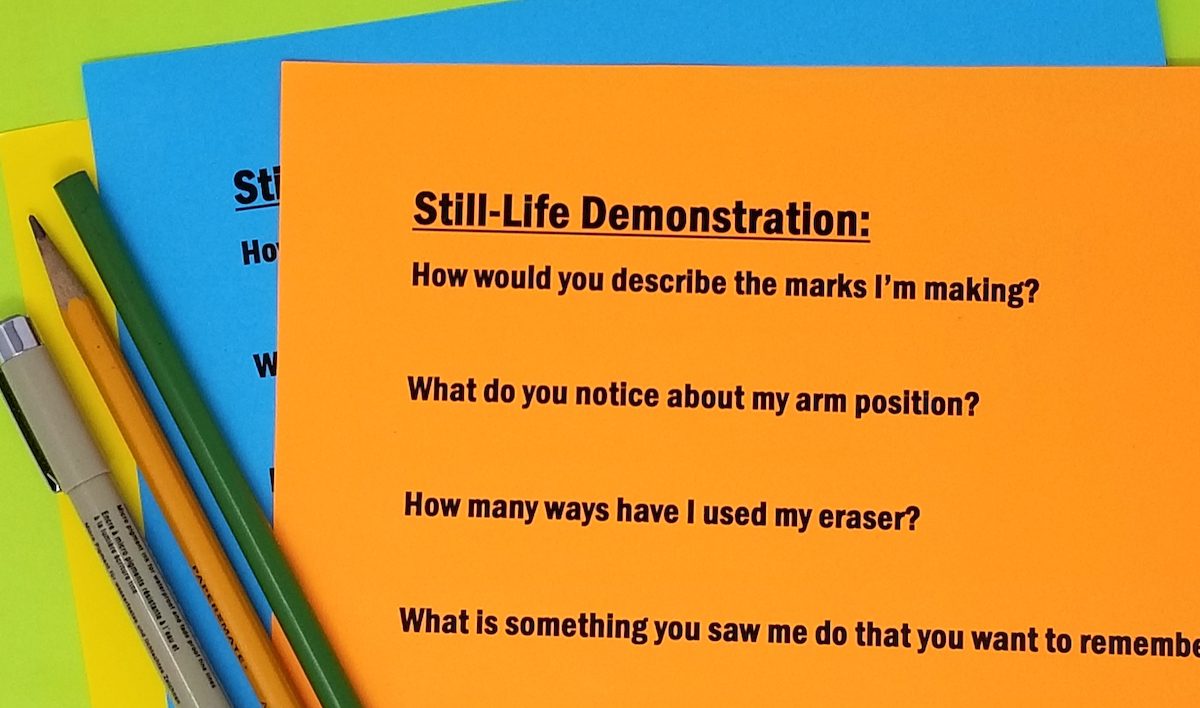Demonstrations are one of the most common practices for art teachers. Yet, even when you nail the demonstration, you still have students return to their seats and immediately ask, “What am I supposed to do?” So frustrating!
Changing your demonstrations to be more effective can have immediate impacts on student learning and your classroom.
Traditional demonstrations feature a teacher at the front and students spectating around the table. Only the teacher talks as students try to observe everything that is happening. But by engaging all students in the demonstration process, they become participants and are more likely to learn the material. Here are some ideas to try for your next demonstration:
Identifying Key Look Fors
Before starting the demonstration, be clear with your students on what they should observe.

Share these and any follow-up questions you will ask in advance to help signal which information is most important. You can also assign questions to individuals or groups of students for more accountability. Look for’s and follow-up questions should be specific and developed to help the student better understand the content. While procedural questions like, “What is the next step?” are important, be sure to emphasize deeper questions that focus more on learning. These might start with phrases like “How would you describe…” or “What did you notice about…”.
Share Your Thoughts
Over-communicate with your students while you’re demonstrating, including your internal dialogue that only you typically hear.
Support every action, even the smallest of moves, with an explanation. If you dip your brush in the water again or grab a different piece of charcoal, share the purpose. Don’t assume your students will understand the why behind your actions. Sharing this level of detail and information with your students will help them better understand how they should be thinking and what to consider when it’s their turn to work.
Teach Beyond and Around the Target
Demonstrations are usually very linear to help students stay on the right track: do this, then this. Besides showing students the path to success, help them see what happens when you stray from that path.

Show students common errors and the impact, like adding too much water, to help them identify those problems when they start to happen. Additionally, showing students how to rebound from these errors can help them become more independent artists and not reliant on you coming to save their work.
Post the Process
By the time you introduce new content to students, you have been thinking about it for weeks (at the least) and planning the best lesson for your class. By now the content is second nature to you, but your students are only hearing it for the first time.
Filling demonstrations with too much information can make it difficult for students to retain everything. To prevent information overload, reserve the demonstration for “how” to do something and post or create an assignment sheet for “what” to do. Separating procedural steps from technical instruction can help students better learn the content and provide a readily available resource to answer the inevitable question, “What do I do next?” If procedural steps require more explanation than posting allows, assign individual students to be the expert of each step and help others in the room.
Prepare, Perform, Present
Do you ever wonder how cooking shows can instruct viewers on how to create a magical dish in such a short amount of time? One of their secrets is to have the ingredients and several versions of the dish prepared in advance.

Bring this strategy into the art room by having your materials and different versions of the lesson already setup or completed. This will help minimize downtime and keep students engaged. Instead of waiting for something to dry before you can go on to the next step, for example, have a dried version ready to go to keep the momentum.
When you can engage students in the demonstration, they have a better understanding of what’s important and what they need to know. Students can return to their seats more confident and ready to move forward, which can domino into other areas of your classroom. Remember with any change to your practice, it will take time for you to figure out what works in your class and to adjust to a new normal. Once you establish these routines and expectations, your demonstrations will be more student-centered with all students participating instead of viewing from the sidelines.
What are other ways to engage students during the demo?
How can you structure demos to meet the varying needs of all students?
Magazine articles and podcasts are opinions of professional education contributors and do not necessarily represent the position of the Art of Education University (AOEU) or its academic offerings. Contributors use terms in the way they are most often talked about in the scope of their educational experiences.





